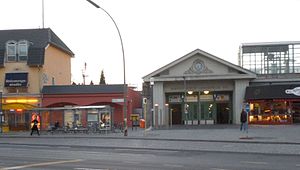Berlin Lichterfelde Ost station
| Through station | |

South-eastern entrance
|
|
| Location |
Lichterfelde, Berlin Germany |
| Coordinates | 52°25′48″N 13°19′44″E / 52.43000°N 13.32889°ECoordinates: 52°25′48″N 13°19′44″E / 52.43000°N 13.32889°E |
| Line(s) |
|
| Platforms |
|
| Construction | |
| Architect | Karl Cornelius, Alfred Lücking |
| Other information | |
| Station code | 7720 |
| DS100 code |
|
| IBNR | 8011041 |
| Category | 3 |
| History | |
| Opened |
|
| Closed | 9 January 1984 |
| Previous names |
|
Berlin-Lichterfelde Ost station is on the Anhalt Suburban Line in Lichterfelde in the Berlin borough of Steglitz-Zehlendorf. It is served by S-Bahn line S25 and Regional-Express lines 3, 4 and 5.
The station was originally called Lichterfelde and opened on 20 September 1868 on the Berlin–Halle railway (Anhalt Railway). It served long-distance trains and was financed by entrepreneur and developer J. A. W. von Carstenn. The tracks of the Anhalt Railway were then still at ground level and the station had only one platform. Suburban trains also stopped there from 1876. In 1881, Siemens & Halske built the first electric tramway in the world, the Lichterfelde–Kadettenanstalt tramway, from the station to the Königlich Preußische Hauptkadettenanstalt (Royal Prussian Military Academy), now the site of the Berlin branch of the German Federal Archives. On 15 July 1884, the station was renamed Groß-Lichterfelde (“Greater Lichterfelde”) after Lichterfelde, Giesensdorf and their estates had been combined into a municipality with this name. Because of its location on the Anhalt Railway from Berlin to Halle (Saale), it was renamed just two years later as Groß-Lichterfelde BH to avoid confusion with the Groß-Lichterfelde BM station on the Berlin–Magdeburg railway, now called Berlin-Lichterfelde West station and operated as part of the Wannsee Railway.
Finally, on 1 January 1899, the name changed again to Groß-Lichterfelde Ost and a second platform, which served the long-distance traffic only, was opened at the same time. Separate suburb tracks were opened to the Potsdamer Ring- und Vorortbahnhof (Ring line and suburban station) in 1901.
...
Wikipedia
